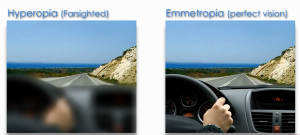Hyperopia – Back to Basics
Hyperopia
Today, we continue on with our back to basics series, discussing refractive errors. To recap, a refractive error means that the eye does not bend or refract light properly to see images clearly or in focus. Having discussed myopia yesterday, or ‘short sightedness’, today we take a look at Hyperopia which is also known as ‘far sightedness’ and ‘long sightedness’.
What is Hyperopia?
Hyperopia, or ‘far / long sightedness’ and is another common refractive error. For hyperopic people, distant objects may be seen more clearly than those objects that are near. For people with higher degrees of hyperopia vision can be blurry for objects at any distance, near or far.
The diagrams below illustrate how light rays enter the eye and are refracted to the retina, in each A): a hyperopic / long sighted eye; B) a normal or ’emmetropic’ eye and C) a short sighted or Myopic eye. As you can see, in a hyperopic eye, which tends to be shorter than average, the focal point of light rays falls after or beyond the retina. This requires optical correction in the form of glasses or contact lenses to push it back so that the light rays meet on the retina. The image being seen by that person is then made clear or in focus.
What are the symptoms of Hyperopia?
Some of the symptoms experienced in undiagnosed hyperopia are:
- difficulty with close tasks like reading
- eyestrain
- squinting to see clearly
- headaches

A simulation of what some Hyperopic people may experience with their vision compared to someonen with perfect vision. http://plaintips.com/hyperopia
Hyperopia in Children
Most children are far sighted, yet they do not experience the same symptoms of blurry vision that an adult may do. This is because children’s eyes are able to bend the light rays to place them directly onto the retina. This process is called ‘accommodation’.
How is Hyperopia diagnosed?
Much like any other refractive error, a comprehensive eye examination with your ophthalmologist will detect hyperopia. A standard vision test followed by a refraction which is performed by the ophthalmologist will reveal the degree of hyperopia and from that, the most appropriate prescription to correct the error and improve visual acuity.
How is Hyperopia Treated?
Eye glasses or contact lenses are the most common methods of correcting vision that is reduced as a result of hyperopia. For some hyperopic patients, refractive surgery may be an option. For patients with a high degree of hyperopia, there may be an increased risk of an acute form of glaucoma called angle closure glaucoma.
For some patients with very short eyes and high hyperopic prescriptions, who are at increased risk of developing glaucoma, there may be indication for other surgical intervention to prevent any episodes which may threaten the vision. To discuss these and determine what is best for your eyes, please consult with your ophthalmologist.
Glasses use curved lenses to refocus light rays onto the cornea
Contact Lenses correct vision in the same way as glasses, only they are placed directly onto the eye.
Refractive Surgery changes the shape of the cornea, by ‘ablating’ or removing corneal tissue to correct low levels of hyperopia.
To make an appointment with one of our Ophthalmologists, please call our rooms on (02) 9241 2913.
References
https://www.aao.org, https://nei.nih.gov


